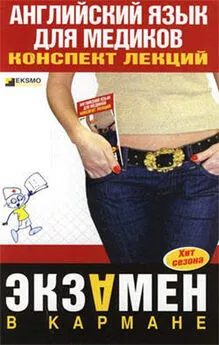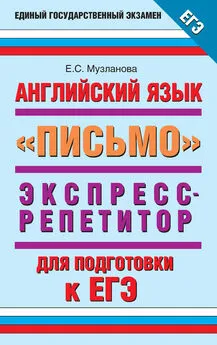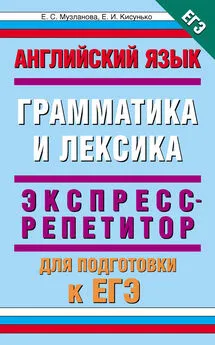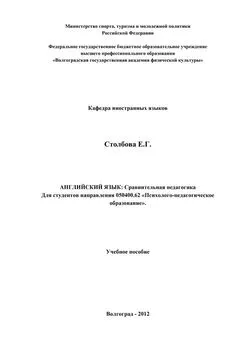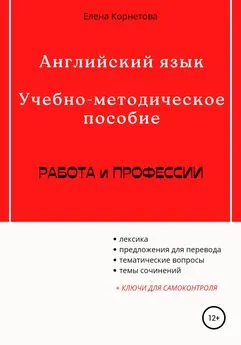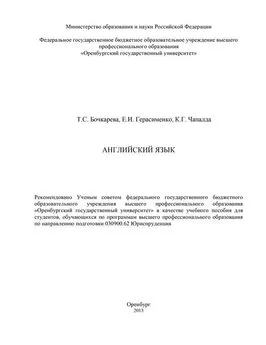Елена Беликова - Английский язык
- Название:Английский язык
- Автор:
- Жанр:
- Издательство:неизвестно
- Год:неизвестен
- ISBN:нет данных
- Рейтинг:
- Избранное:Добавить в избранное
-
Отзывы:
-
Ваша оценка:
Елена Беликова - Английский язык краткое содержание
Студенту без шпаргалки никуда! Удобное и красивое оформление, ответы на все экзаменационные вопросы ведущих вузов России.
Английский язык - читать онлайн бесплатно ознакомительный отрывок
Интервал:
Закладка:
The dermomyotome further differentiates into the myo-tome and the dermatome.
Cells of the myotome migrate ventrally to surround the in-traembryonic coelom and the somatic mesoderm of the ventrolateral body wall. These myoblasts elongate, become spindle-shaped, and fuse to form multinucleated muscle fibers.
Myofibrils appear in the cytoplasm, and, by the third month, cross-striations appear. Individual muscle fibers increase in diameter as myofibrils multiply and become arranged in groups surrounded by mesenchyme.
Individual muscles form, as well as tendons that connect muscle to bone.
Trunk musculature: By the end of the fifth week, body-wall musculature divides into a dorsal epimere, supplied by the dorsal primary ramus of the spinal nerve, and a ventral hypomere, supplied by the ventral primary ramus.
Epimere muscles form the extensor muscles of the vertebral column, and hypomere muscles give rise to lateral and ven tral flexor musculature.
The hypomere splits into three layers. In the thorax, the three layers form the external costal, internal intercostal, and transverse thoracic muscle.
In the abdomen, the three layers form the external oblique, internal oblique, and transverse abdomii muscles.
Head musculature.
The extrinsic and intrinsic muscles of the tongue are thought to be derived from occipital myotomes that migrate forward.
The extrinsic muscles of the eye may derive from preoptic myotomes that originally surround the prochordal plate.
The muscles of mastication, facial expression, the pharynx, and the larynx are derived from different pharyngeal arches and maintain their innervation by the nerve of the arch of origin.
Limb musculature originates in the seventh week from soma mesoderm that migrates into the limb bud. With time, the limb musculature splits into ventral flexor and dorsal extern groups.
The limb is innervated by spinal nerves, which penetrate the limb bud mesodermal condensations. Segmental branches of the spinal nerves fuse to form large dorsal a ventral nerves.
The cutaneous innervation of the limbs is also derived from spinal nerves and reflects the level at which the limbs arise.
Smooth muscle: the smooth muscle coats of the gut, trachtea, bronchi, and blood vessels of the associated mesenteries are derived from splanchnic mesoderm surrounding the gastrointestinal tract. Vessels elsewhere in the body obtain their coat from local mesenchyme.
Cardiac muscle, like smooth muscle, is derived from splanchnic mesoderm.
ventral – брюшной
somatic – соматический
cytoplasm – цитоплазма
cross-striations – поперечные бороздчатости
extensor – разгибающая мышца
dorsal – спинной
ivertebral – позвоночный
arche – дуга
abdomen – живот
facial – лицевой
branch – ветвь
10. Skeleton
The bones of our body make up a skeleton. The skeleton forms about 18 % of the weight of the human body.
The skeleton of the trunk mainly consists of spinal column made of a number of bony segments called vertebrae to which the head, the thoracic cavity and the pelvic bones are connected. The spinal column consists of 26 spinal column bones.
The human vertebrae are divided into differentiated groups. The seven most superior of them are the vertebrae called the cervical vertebrae. The first cervical vertebra is the atlas. The second vertebra is called the axis.
Inferior to the cervical vertebrae are twelve thoracic vertebrae. There is one rib connected to each thoracic vertebrae, making 12 pairs of ribs. Most of the rib pairs come together ventrally and join a flat bone called the sternum.
The first pairs or ribs are short. All seven pairs join the sternum directly and are sometimes called the «true ribs». Pairs 8, 9, 10 are «false ribs». The eleventh and twelfth pairs of ribs are the «floating ribs».
Inferior to the thoracic vertebrae are five lumbar vertebrae. The lumbar vertebrae are the largest and the heaviest of the spinal column. Inferior to the lumbar vertebrae are five sacral vertebrae forming a strong bone in adults. The most inferior group of vertebrae are four small vertebrae forming together the соссуx.
The vertebral column is not made up of bone alone. It also has cartilages.
skeleton – скелет
make up – составлять
weight – вес
trunk – туловище
vertebrae – позвоночник
thoracic cavity – грудная клетка
pelvic – тазовый
cervical – шейный
atlas – 1 шейный позвонок
sternum – грудина
mainly – главным образом
axis – ось
spinal column – позвоночник
inferior – нижний
rib – ребро
pair – пара
sacral – сакральный
соссуx – копчик
floating – плавающий
forming – формирующий
cartilage – хрящ
lumbar – поясничный
adult – взрослый
11. Muscles
Muscles are the active part of the motor apparatus; their contraction produces various movements.
The muscles may be divided from a physiological standpoint into two classes: the voluntary muscles, which are under the control of the will, and the involuntary muscles, which are not.
All muscular tissues are controlled by the nervous system.
When muscular tissue is examined under the microscope, it is seen to be made up of small, elongated threadlike cells, which arc called muscle fibres, and which are bound into bundles by connective tissue.
There are three varieties of muscle fibres:
1) striated muscle fibres, which occur in voluntary muscles;
2) unstriated muscles which bring about movements in the internal organs;
3) cardiac or heart fibres, which are striated like (1), but are otherwise different.
Muscle consists of threads, or muscle fibers, supported by connective tissue, which act by fiber contraction. There are two types of muscles smooth and striated. Smooth, muscles are found in the walls of all the hollow organs and tubes of the body, such as blood vessels and intestines. These react slowly to stimuli from the autonomic nervous system. The striated, muscles of the body mostly attach to the bones and move the skeleton. Under the microscope their fibres have a cross – striped appearance. Striated muscle is capable of fast contractions. The heart wall is made up of special type of striated muscle fibres called cardiac muscle. The body is composed of about 600 skeletal muscles. In the adult about 35–40 % of the body weight is formed by the muscles. According to the basic part of the skeleton all the muscles are divided into the muscles of the trunk, head and extremities.
According to the form all the muscles are traditionally divided into three basic groups: long, short and wide muscles. Long muscles compose the free parts of the extremities. The wide muscles form the walls of the body cavities. Some short muscles, of which stapedus is the smallest muscle in the human body, form facial musculature.
Some muscles are called according to the structure of their fibres, for example radiated muscles; others according to their uses, for example extensors or according to their directions, for example, – oblique.
Great research work was carried out by many scientists to determine the functions of the muscles. Their work helped to establish that the muscles were the active agents of motion and contraction.
muscles – мышцы
active – активный
motor apparatus – двигательный аппарат
various – различный
movement – движение
elongated – удлиненный
threadlike – нитевидный
be bound – быть связанным
ability – возможность
capable – способность
scientist – ученый
basic – основной
12. Bones
Bone is the type of connective tissue that forms the body s supporting framework, the skeleton. Serve to protect the internal organs from injury. The bone marrow inside the bones is the body's major producer of both red and white blood cells.
The bones of women are generally lighter than those of men, while children's bones are more resilient than those of adults Bones also respond to certain physical physiological changes: atrophy, or waste away.
Bones are generally classified in two ways. When classified on the basis of their shape, they fall into four categories: flat bones, such as the ribs; long bones, such as the thigh bone; short bones, such as the wrist bones; and irregular bones, such as the vertebrae. When classified on the basis of how they develop, bones are divided into two groups: endochondral bones and intramembraneous bones. Endochondral bones, such as the long bones and the bones at the base of the skull, develop from cartilage tissue Intramembraneous bones, such as the flat bones of the roof of the skull, are not formed from cartilage but develop under or within a connective tissue membrane. Although endochondral bones and intramembraneous bones form in different ways, they have the same structure.
The formation of bone tissue (ossification) begins early in embryological development. The bones reach their full size when the person is about 25.
Most adult bone is composed of two types of tissue: anouter layer of compact bone and an inner layer of spongy bone. Compact bone is strong and dense. Spongy bone is light and porous and contains bone marrow The amount of each type of tissue varies in different bones. The flat bones of the skull consist almost entirely of compact bone, with very little spongy tissue. In a long bone, such as the thigh bone, the shaft, called the diaphysis, is made up largely of compact bone. While the ends, called epyphyses, consist mostly of spongy bone. In a long bone, marrow is also present inside the shaft, in a cavity called the medullary cavity.
Surrounding every bone, except at the surface where it meets another bone, is a fibrous membrane called the periosteum. The outer layer of the periosteum consists of a network of densely packed collagen fibres and blood vessels. This layer serves for the attachment of tendons, ligaments, and muscles to the bone and is also important in bone repair.
The inner layer of the periosteum has many fibres, called fibres of Sharpey, which penetrate the bone tissue, anchoring the periosteum to the bone. The inner layer also has many bone-forming cells, or osteoblasts, which are responsible for the bone's growth in diameter and the production of new bone tissue in cases of fracture, infection.
In addition to the periosteum, all bones have another membrane, the endosteum. It lines the marrow cavity as well as the smaller cavities within the bone. This membrane, like the inner layer of the periosteum, contains os-teoblasts, and is important in the formation of new bone tissue.
13. Bones. Chemical structure,
Bone tissue consists largely of a hard substance called the matrix. Embedded in the matrix are the bone cells, or osteocytes. Bone matrix consists of both organic and inorganic materials. The organic portion is made up chiefly of collagen fibres. The inorganic portion of matrix constitutes about two thirds of a bone's total weight. The chief inorganic substance is calcium phosphate, which is responsible for the bone's hardness. If the organic portion were burned out the bone would crumble under the slightest pressure. In the formation of intramembraneous bone, certain cells of the embryonic connective tissue congregate in the area where the bone is to form. Small blood vessels soon invade the area, and the cells, which have clustered in strands, undergo certain changes to become osteoblasts. The cells then begin secreting collagen fibers and an intercellular substance. This substance, together with the collagen fibers and the connective tissue fibers already present, is called osteoid. Osteoid is very soft and flexible, but as mineral salts are deposited it becomes hard matrix. The formation of endochondral bone is preceded by the formation of a cartilaginous structure similar in shape to the resulting bone. In a long bone, ossification begins in the area that becomes the center of the shaft. In this area, cartilage cells become osteoblasts and start forming bone tissue This process spreads toward either end of the bone. The only areas where cartilage is not soon replaced by bone tissue are the regions where the shaft joins the two epiphyses. These areas, called epiphyseal pla-res, are responsible for the bones continuing growth in length. The bone's growth in diameter is due to the addition of layers of bone around the outside of the shaft As they are formed, layers of bone on the inside of the shaft are removed. In all bones, the matrix is arranged in layers called lamellae. In compact bone, the lamellae are arranged concentrically around blood vessels, and the space containing each blood vessel is called a Haver-sian canal. The osteocytes are located between the lamellae, and the canaliculi containing their cellular extensions connect with the Haversian canals, allowing the passage of nutrients and other materials between the cells and the blood vessels. Bone tissue contains also many smaller blood vessels that extend from the periosteum and enter the bone through small openings. In long bones there is an additional blood supply, the nutrient artery, which represents the chief blood supply to the marrow. The structure of spongy is similar to that of compact bone. However, there are fewer Haversian canals, and the lamellae are arranged in a less regular fashion, forming spicules and strands known as trabeculae.
Читать дальшеИнтервал:
Закладка:


